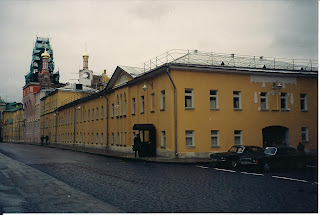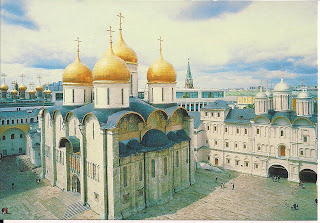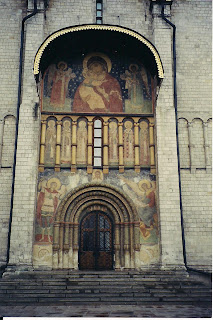World Adventurer (December 5, 2003 Chautauqua)
In Russia, a "kremlin" is a Russian town's
fortified stronghold, and Moscow Red Square on the
eastern side.
A map of the Kremlin
The "White Stone
Kremlin" - which had limestone walls - was built in the 1360's with almost
the same boundaries of today. This lasted until 1475-1516, when an era of
rebuilding was undertaken by Ivan the Great. Master builders from Pskov and Italy
Even after Peter the Great shifted
the capital to St. Petersburg Cat herine
the Great contemplated building a new, classical Kremlin in the 1770's, but she
ran out of money.
Napoleon's troops were making
preparations to blow it up, blow it up good, blow it up real good, heh heh heh; but were foiled by rain and the
timely arrival of Russian soldiers.
Hitler had planned to raze the
entire city of Moscow
I contemplated my
"assault" on the site from one of the most visible monuments to Russia Moscow
Tomb of the Unknown Soldier
Stretching south from the tomb is the
Trinity Gate Tower
The lane to the right (south)
immediately inside the Trinity Gate Tower, runs between the 17th century
Poteshney Palace (Poteshny dvorets) where Stalin lived, and a great glass monolith
of a building, the 20th century Palace of Congresses.
Poteshney Palace
The Arsenal, with Napoleonic cannon (on carriages),
and tubes (lined up between the carriages)
The Senate (left) and the Supreme Soviet (right)
Grouped in the centre of the
Kremlin are its chief glories, the cathedrals.
The AssumptionCat hedral has five golden helmet domes and four
semicircular gables facing the square. This was the focal church of
pre-revolutionary Russia
Beside the western door of the
Assumption
The Assumption Cathedral
The Assumption
Just to the south is the Ivan the Great Bell
Tower Moscow
In front of this cathedral are the
Tsar Bell and the Tsar Cannon. The former is the world's largest bell, a 202
tonne monster that never rang. It was cast in the 1730's for the Empress Anna
Ivanovna. As it was cooling off in a foundry casting pit, water being poured to
cool the fires nearby came into contact with the bell, causing an 11 tonne
chunk to fall off.
Ivan the Great Bell Tower
The cannon was cast in 1586 for Fyodor I, whose portrait is on the barrel. The bore is 89 cm!
The Archangel
Ivan the Terrible lies here, but
his tomb is out of sight behind a wall of icons, as are the tombs of two of his
sons: Ivan (whom he killed), and Fyodor (who succeeded him). From Peter the
Great onward, emperors and empresses were buried in St. Petersburg
The Annunciation Cat hedral (Blagoveshchensky sobor) at the
southwestern corner of the square has what are described as the "greatest
icons by the greatest icon painter, Theophanes the Greek."
Icons are depictions of saints and
other characters from the Bible. Some of them are indeed quite beautiful, but
the multitude that are on display in these and other churches can lessen a
person's appreciation for what he is seeing.
The one other sight to see in the
Kremlin is the Armoury (Oruzheynaya palata), which houses a vast array of the
treasures accumulated by the tsars.
There are nine rooms: rooms 1 to 5 are upstairs, 6 to 9 downstairs.
Room 3 has the renowned Easter
eggs of precious metals and jewels by the St.
Petersburg
Room 6 contains thrones and royal
regalia, including the 800 diamond throne of Tsar Alexey, the jewel-studded,
sable-trimmed gold Cap of Monomakh, and the coronation dresses of 18th century
empresses.
Room 9 holds many coaches, including the sleigh that Empress Elizabeth rode from
The Great Kremlin Palace
Between the Armoury and the Annunciation
Once I was finished seeing all
these sights, my day in Moscow Poland













No comments:
Post a Comment